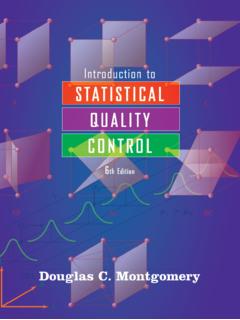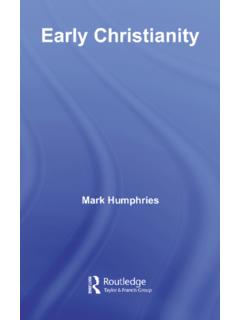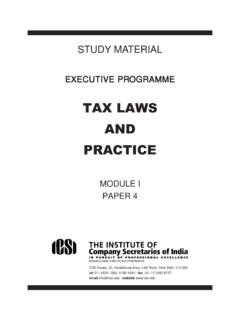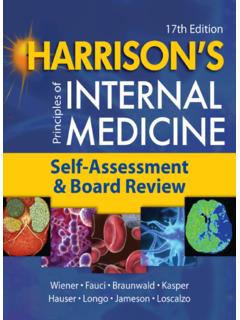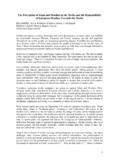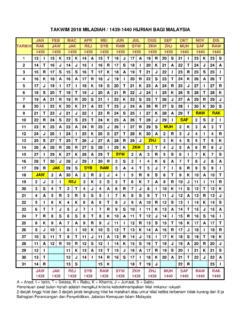Transcription of Islam - Religion, History, and Civilization - dl4a.org
1 Islam . religion , history , and Civilization Seyyed Hossein Nasr FOR SINA. Contents Epigraph vi Introduction vii 1. Islam and the Islamic World 1. 2. Islam as religion 25. 3. Doctrines and Beliefs of Islam 59. 4. The Dimensions of Islam 75. 5. Islamic Practices, Ethics, and Institutions 91. 6. A Brief Journey Through Islamic history 115. 7. Schools of Islamic Thought and Their history 153. 8. Islam in the Contemporary World 173. Notes 187. Recommended Reading 189. Index 193. About the Author Cover Copyright About the Publisher In the Name of God, the Infinitely Good, the All-Merciful Introduction Islam is both a religion and a Civilization , a historical reality that spans over fourteen centuries of human history and a geographical presence in vast areas stretching over the Asian and African continents and even parts of Europe.
2 It is also a spiritual and metahistorical reality that has trans- formed the inner and outer life of numerous human beings in very different temporal and spatial circumstances. Today over billion people from different racial and cultural backgrounds are Muslim, and historically Islam has played a significant role in the development of certain aspects of other civilizations, especially Western Civilization . Not only is Islam a major presence in today's world, but its influence is also evident in the history of the Christian West, not to mention that of India and other regions of Asia and Africa. That is why knowledge of Islam is so important for those concerned with the situation of contemporary humanity and those interested in Western intellectual and cultural history , as well as those attracted to the reality of religion and the world of the Spirit as such.
3 Vii viii Introduction One would think, therefore, that the study of Islam would be widespread in the West and especially in America, which has a notable Muslim minority and which is now able to project so much power globally including within the Islam - ic world. Such, however, is not the case, despite the rise of interest in Islam since the tragic events of September 11, 2001. Moreover, much that is presented today in the English language as the study of Islam by so-called experts is strong- ly colored by various prejudices and ideological biases, although there are exceptions. In fact, although Islamic stud- ies have been carried out in the West for over a thousand years, in each period such studies have been distorted and tainted by a particular set of errors and deviations.
4 The study of Islam in the West began in the tenth and eleventh centuries. Because this was a time in which Europe was thoroughly Christian, Islam was seen as a Christian heresy, and its founder as an apostate. Soon the imminent threat to Western Christendom from Islam led many to call the Prophet of Islam the Antichrist, and the Quran itself was translated by order of Peter the Venerable in order to be refuted and rejected as sacred scripture. The Middle Ages were marked by strong religious opposition to Islam . Yet it was at this time that the West showed the greatest interest in Islamic thought, including philosophy and the sciences, and Islamic education, arts, and technology were greatly respect- ed.
5 The first translations into Latin of works of Islamic thought, ranging from philosophy and even theology to astronomy, mathematics, and medicine, belong to this Introduction ix period. Formal Islamic studies in the West may in fact be said to have begun during the Middle Ages. The Renaissance perpetuated religious opposition to Islam , but also began to show disdain not only for Europe's own medieval past, but also for Islamic learning, although there were some exceptions. Furthermore, the emphasis on Euro-centrism during the Renaissance and the rise of humanism caused many European thinkers of that time to consider people of other civilizations and ethnic groups, including Muslims, inferior.
6 Although Islamic studies were still carried on during the Renaissance, and in some places, such as Bologna, even within the framework of the older medieval respect for Islamic thought, in many places they were distorted by a sense of Western superiority and even hubris, characteristics that were to continue into the modern period. The Enlightenment turned against the theological asser- tions of Christianity and substituted rationalism for a world- view based on faith. Moreover, it further developed the idea that there was only one Civilization , the Western one, and that other civilizations were significant only to the extent of their contribution to Western Civilization , which the French Encyclopedists referred to as the Civilization (la civilisa- tion).
7 Obviously in such a situation Islam and its Civilization could only play an inferior and secondary role. Although some new translations of Islamic sources were made into European languages at this time and Islamic studies remained an intellectual and academic discipline, little was done to understand the teachings of Islam on their own terms. Many of the leading thinkers x Introduction of this period, in fact, maintained the older European dis- dain for Islam , but at the same time tried to make use of some of its teachings to attack Christianity. Such a dual atti- tude toward Islam is evident in the works of Voltaire, among others. During the nineteenth century, historicism in its absolut- ist sense took the center of the philosophical stage with Hegel, who considered all other civilizations stages in the march of the Geist in time leading to the final stage, which was supposedly realized in modern Western history .
8 And yet this was also the period when the Romantic movement began, when many minds, tired of the rationalism of the Enlightenment, turned anew to the Middle Ages as well as to seeking meaning beyond the borders of the West. This was the period when many of the greatest spiritual master- pieces of Islamic literature, especially many of the Sufi clas- sics, were translated into German, English, and French and seriously attracted major Western writers and thinkers, such as Goethe, R ckert, and Emerson. This was also the period when the exotic image of the Islamic East, with its mysteri- ous casbahs and h. arams full of nude females, developed, as reflected in nineteenth-century European art associated with orientalism.
9 Moreover, this period marked the beginning of official ori- ental studies, including Islamic studies, in various Western universities, often supported by colonial governments such as those of Britain, France, the Netherlands, and Russia. Oriental studies, in fact, developed as an instrument for furthering the policy of colonial powers, whether they were carried out in Central Asia for use by the Russian colonial office or in India Introduction xi for the British government. But there were among the orien- talists in the late nineteenth and first half of the twentieth century also a number of noble scholars who studied Islam both objectively and with sympathy, such as Thomas Arnold, Sir Hamilton Gibb, Louis Massignon, and Henry Corbin.
10 Later Western orientalists who belong to this tradition include Marshall Hodgson, Annemarie Schimmel, and sev- eral other important scholars. But the main product of the orientalist manner of studying Islam remained heavily biased not only as a result of the interests of those powers it was serving, but also through the absolutization of current Western concepts and methodologies that were applied to Islam with the sense of superiority and hubris going back to the Renaissance definition of the European man.. The last half of the twentieth century witnessed a major transformation in Islamic studies in the West, at least in cer- tain circles.
